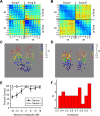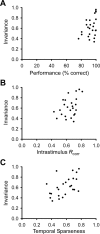Invariance and sensitivity to intensity in neural discrimination of natural sounds
- PMID: 18562600
- PMCID: PMC2730838
- DOI: 10.1523/JNEUROSCI.0961-08.2008
Invariance and sensitivity to intensity in neural discrimination of natural sounds
Abstract
Intensity variation poses a fundamental problem for sensory discrimination because changes in the response of sensory neurons as a result of stimulus identity, e.g., a change in the identity of the speaker uttering a word, can potentially be confused with changes resulting from stimulus intensity, for example, the loudness of the utterance. Here we report on the responses of neurons in field L, the primary auditory cortex homolog in songbirds, which allow for accurate discrimination of birdsongs that is invariant to intensity changes over a large range. Such neurons comprise a subset of a population that is highly diverse, in terms of both discrimination accuracy and intensity sensitivity. We find that the neurons with a high degree of invariance also display a high discrimination performance, and that the degree of invariance is significantly correlated with the reproducibility of spike timing on a short time scale and the temporal sparseness of spiking activity. Our results indicate that a temporally sparse spike timing-based code at a primary cortical stage can provide a substrate for intensity-invariant discrimination of natural sounds.
Figures



References
-
- Barak O, Tsodyks M. Recognition by variance: learning rules for spatiotemporal patterns. Neural Comput. 2006;18:2343–2358. - PubMed
-
- Bendor D, Wang X. Differential neural coding of acoustic flutter within primate auditory cortex. Nat Neurosci. 2007;10:763–771. - PubMed
-
- Brody CD, Hopfield JJ. Simple networks for spike-timing-based computation, with application to olfactory processing. Neuron. 2003;37:843–852. - PubMed
-
- Buonomano DV, Merzenich M. A neural network model of temporal code generation and position-invariant pattern recognition. Neural Comput. 1999;11:103–116. - PubMed
Publication types
MeSH terms
Grants and funding
LinkOut - more resources
Full Text Sources
